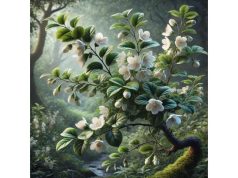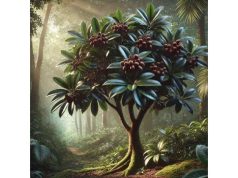
The Ebony Tree is one of nature’s most revered treasures—a majestic, slow-growing tropical hardwood celebrated for its deep, rich, almost jet-black heartwood and remarkable durability. Belonging to the genus Diospyros within the Ebenaceae family, the Ebony Tree has captivated artisans, architects, and naturalists for centuries. Renowned for its luxurious appearance and extraordinary strength, ebony wood has been used to create exquisite furniture, musical instruments, carvings, and decorative objects that stand as symbols of wealth, refinement, and cultural heritage. Its dense, fine-grained wood is not only admired for aesthetic beauty but also for its resistance to decay, making it a premium material in construction and artistry.
Historically, the Ebony Tree has held a prominent place in human culture and commerce. From ancient Egyptian tombs to medieval European palaces, ebony has adorned the finest artifacts and royal possessions. Its use spread across continents as explorers and traders sought its unique qualities, and today, sustainable forestry practices aim to balance its high demand with the need for conservation. In addition to its material value, modern research has begun to explore the tree’s potential medicinal and environmental benefits, including its role in carbon sequestration and its bioactive properties in traditional remedies.
Ebony’s allure is multidimensional. It transcends being merely a timber species; it is a symbol of nature’s artistry and a cornerstone in the evolution of fine craftsmanship. Whether you are an artisan, a conservationist, or simply an admirer of natural beauty, the Ebony Tree offers a rich legacy of history, innovation, and ecological significance.
- Provides a premium, durable wood with a striking, deep black appearance
- Holds a rich historical and cultural legacy across civilizations
- Offers potential medicinal and bioactive properties from its bark and leaves
- Supports sustainable forestry and carbon sequestration efforts when responsibly managed
- Enhances fine art, musical instruments, and luxury furniture with its unique aesthetic
Table of Contents
- Ebony Tree Botanical Profile and Key Characteristics
- Ebony Tree Historical Legacy and Cultural Significance
- Ebony Tree Phytochemical Composition and Bioactive Elements
- Ebony Tree Benefits and Natural Properties
- Ebony Tree Applications and Safety Considerations
- Ebony Tree Research Insights and Recent Studies
- Ebony Tree Frequently Asked Questions (FAQ)
Ebony Tree Botanical Profile and Key Characteristics
Ebony trees are tropical hardwoods that belong to the genus Diospyros. With over 400 species distributed throughout Africa, Asia, and the Americas, these trees share several defining botanical features that have captivated botanists and woodworkers alike. The most celebrated species are known for producing wood of unparalleled density and darkness—a true natural marvel.
Taxonomy and Morphology
- Family and Genus:
Ebony trees are members of the Ebenaceae family, with the genus Diospyros encompassing a diverse range of species. Among these, species such as Diospyros crassiflora (African ebony) and Diospyros ebenum (Indian ebony) are particularly renowned for their commercial and cultural value. - Leaves and Foliage:
The foliage of the Ebony Tree is typically evergreen, with simple, oblong leaves that are glossy and leathery in texture. These leaves are adapted to thrive in the humid, tropical climates where the trees flourish, capturing sunlight efficiently while conserving moisture. The vibrant green leaves provide a stunning contrast to the tree’s dark trunk and wood, adding to its overall visual appeal. - Flowers and Fruits:
Ebony trees produce small, inconspicuous flowers that are usually white or cream in color. These flowers give way to berry-like fruits which, although not as celebrated as the wood itself, play an important role in the tree’s reproductive cycle. The fruits are often consumed by local wildlife, facilitating seed dispersal and ensuring the continuation of the species. - Wood Characteristics:
The true marvel of the Ebony Tree lies in its heartwood—a dense, heavy material with an almost inky-black color, interspersed with subtle brown streaks. This wood is highly prized not only for its aesthetic qualities but also for its resistance to decay, low porosity, and remarkable durability. Its fine texture and natural luster make it a favorite for high-end applications in furniture, sculpture, and musical instruments.
Habitat and Growth Conditions
Ebony trees thrive in tropical regions where the climate is warm and humid. They typically grow in lowland forests and secondary growth areas, often in regions with well-drained, fertile soils. Their slow growth rate is a key factor in the development of their dense heartwood, which can take many decades to form. Unfortunately, this slow maturation also makes them particularly vulnerable to overharvesting, a challenge that has spurred global conservation efforts.
Ecological Adaptations
The Ebony Tree is adapted to compete in the densely vegetated, competitive environments of tropical forests. Its deep root system helps stabilize the soil and withstand periods of heavy rainfall and seasonal flooding. Moreover, the tree’s ability to produce a high-density, durable wood is an evolutionary adaptation to deter pests and resist natural decay, ensuring its survival over long periods.
Visual and Functional Attributes
In addition to its ecological functions, the Ebony Tree is celebrated for its stunning visual attributes. The contrast between its lush, green foliage and the deep, dark wood creates a striking aesthetic that has been admired in art and architecture for centuries. Its wood’s fine grain and smooth finish also make it an ideal canvas for detailed carvings and intricate designs, ensuring its place in both functional and decorative applications.
Ebony Tree Historical Legacy and Cultural Significance
The historical legacy of the Ebony Tree is as rich and complex as its dark, lustrous wood. For millennia, ebony has symbolized wealth, power, and refinement across diverse cultures. Its story is interwoven with the rise and fall of empires, the expansion of trade routes, and the evolution of art and craftsmanship.
Ancient and Medieval Uses
- Antiquity:
In ancient civilizations such as Egypt and Greece, ebony was regarded as a precious resource. Its dense, dark wood was often reserved for the most prestigious purposes, including the creation of sacred objects, fine furniture, and decorative inlays. Egyptian tombs and Greek temples have featured ebony accents, signifying its association with the divine and the eternal. - Medieval Europe:
During the medieval period, ebony became a symbol of nobility and high status. European artisans and craftsmen used ebony for intricate carvings, religious icons, and luxury items that adorned the courts of kings and queens. The wood’s rarity and cost made it a marker of social distinction, and its use in heraldry and ceremonial objects reinforced its cultural prestige.
Trade and Economic Impact
The global demand for ebony has historically driven extensive trade networks. African and Asian ebony species were highly sought after by European traders, leading to significant economic interactions that shaped colonial and post-colonial trade patterns. The exploitation of ebony resources, however, also led to overharvesting and deforestation, prompting early discussions on sustainable management practices—a concern that continues to resonate in modern forestry and conservation efforts.
Symbolism and Artistry
Ebony’s dark, enigmatic beauty has inspired countless works of art and cultural expressions. In many cultures, ebony is more than just a material; it is a symbol of mystery, strength, and resilience. Carvers, sculptors, and musicians have long revered the wood for its ability to convey deep emotions and narratives through its rich, textured surfaces. Ebony has graced the pages of literature and the canvases of painters, often representing themes of permanence and the passage of time.
Conservation and Cultural Revival
The historical exploitation of ebony has led to serious conservation challenges in recent decades. Overharvesting, habitat loss, and illegal logging have all contributed to the decline of ebony populations in many regions. In response, governments, international organizations, and local communities have launched conservation initiatives to protect remaining ebony stands and promote sustainable harvesting practices. This renewed focus on conservation is not only an environmental imperative but also a cultural revival—a commitment to preserving a material that embodies centuries of human history and artistic expression.
Ebony Tree Phytochemical Composition and Bioactive Elements
While the Ebony Tree is most famously known for its premium timber, it also contains a range of bioactive compounds that have captured the interest of researchers and traditional healers alike. The chemical constituents found in various parts of the tree—such as the bark, leaves, and sap—offer intriguing insights into its potential medicinal applications.
Key Bioactive Components
- Polyphenols and Flavonoids:
Ebony bark and leaves are rich in polyphenolic compounds and flavonoids, which are known for their antioxidant properties. These compounds help neutralize free radicals, thereby protecting cells from oxidative stress and contributing to overall health. Traditional medicine has often harnessed these antioxidants in remedies aimed at reducing inflammation and supporting cardiovascular health. - Tannins:
Tannins are naturally occurring polyphenols present in ebony bark. They possess astringent properties that have been used in traditional medicine to treat wounds, reduce bleeding, and combat infections. The presence of tannins also contributes to the wood’s resistance to decay and insect attack, further underscoring ebony’s natural durability. - Alkaloids and Terpenoids:
Although less extensively studied in ebony compared to other medicinal plants, some research has indicated the presence of alkaloids and terpenoids in the tree’s extracts. These compounds may offer mild antimicrobial and anti-inflammatory effects, suggesting potential applications in natural therapies. Ongoing studies aim to isolate and better understand these substances, with the hope of developing standardized extracts for medicinal use.
Synergistic Effects and Bioavailability
The therapeutic potential of ebony is often attributed to the synergistic interactions between its various bioactive compounds. When used in traditional remedies, the combined effects of antioxidants, tannins, and other phytochemicals can enhance overall bioavailability and efficacy. Modern extraction techniques, such as high-performance liquid chromatography (HPLC) and mass spectrometry, are being employed to profile these compounds accurately and to optimize their use in both topical and internal formulations.
Implications for Traditional and Modern Medicine
Historically, certain communities have utilized ebony extracts as part of their medicinal practices—employing decoctions of bark or leaf extracts to treat a range of ailments from digestive issues to skin infections. Modern research is beginning to validate some of these traditional uses, with preliminary studies suggesting that ebony’s phytochemical profile may indeed offer tangible health benefits. As further research is conducted, there is potential for the development of new, evidence-based applications of ebony extracts in natural and integrative medicine.
Future Research Directions
Continued investigation into the phytochemical composition of the Ebony Tree is essential for unlocking its full therapeutic potential. Future studies are likely to focus on:
- Isolating and characterizing individual bioactive compounds
- Determining the pharmacokinetics and mechanisms of action of these compounds
- Conducting clinical trials to assess efficacy and safety in various therapeutic contexts
Ebony Tree Benefits and Natural Properties
Ebony is celebrated not only for its unmatched aesthetic and structural qualities but also for a range of benefits that extend from practical applications to potential health and environmental advantages. Its unique properties have made it a vital resource across various industries, and emerging research suggests that it may also offer health benefits that resonate with traditional uses.
Core Benefits
- Exquisite Aesthetic and Durability:
The hallmark of ebony is its deep, rich, almost velvety black wood. This characteristic makes it a prized material in fine furniture, musical instruments, and decorative objects. Its density and resistance to wear ensure that items crafted from ebony retain their beauty over generations. - Cultural and Historical Value:
Ebony’s longstanding role in art, craftsmanship, and ceremonial objects has imbued it with significant cultural and historical value. Its rarity and the skill required to work with it have long made ebony a symbol of prestige and sophistication. - Potential Health and Medicinal Properties:
Traditional remedies utilizing ebony extracts have been reported to alleviate minor infections, reduce inflammation, and provide antioxidant support. Although more research is needed, early studies suggest that compounds in ebony may contribute to these health benefits. - Environmental and Economic Contributions:
Ebony trees play a crucial role in tropical forest ecosystems. When managed sustainably, they contribute to carbon sequestration, soil stabilization, and biodiversity. Their economic value also supports local communities, particularly when sustainable harvesting and fair-trade practices are employed. - Sustainability and Conservation:
Modern conservation efforts aim to balance ebony’s high demand with the need to preserve natural populations. Sustainable forestry practices not only protect these slow-growing trees but also ensure that future generations can benefit from their ecological and economic contributions.
Holistic Impact
Beyond tangible applications, ebony offers a holistic benefit by connecting people to nature’s intrinsic beauty and cultural heritage. The deep, resonant hues of ebony evoke a sense of timelessness and respect for craftsmanship that transcends mere material value. This intangible legacy continues to inspire artists, designers, and conservationists around the world.
Ebony Tree Applications and Safety Considerations
Ebony’s unique properties have led to its diverse range of applications, spanning from luxury goods and fine art to potential medicinal uses. However, the high value and rarity of ebony also necessitate careful consideration regarding its use, handling, and conservation.
Practical Applications
- Fine Furniture and Woodcraft:
Ebony’s dense, durable, and exquisitely dark wood is highly prized in the world of fine furniture and woodcraft. Master artisans use ebony to create intricate carvings, inlays, and decorative elements in high-end furniture. Its resistance to wear and decay makes it a lasting investment in craftsmanship. - Musical Instruments:
Ebony has been a preferred material for components of musical instruments, including piano keys, guitar fingerboards, and woodwind parts. Its smooth texture and tonal properties contribute to superior sound quality and a refined playing experience. - Luxury Decorative Objects:
Carvings, sculptures, and ornamental items crafted from ebony are symbols of luxury and sophistication. The wood’s natural luster and fine grain allow for detailed artistry that is both functional and aesthetically captivating. - Traditional and Emerging Medicinal Uses:
In certain cultures, extracts from ebony bark and leaves have been incorporated into traditional remedies aimed at treating inflammation, skin conditions, and minor infections. While these uses remain largely anecdotal, preliminary research suggests potential bioactive properties that warrant further study. - Environmental and Architectural Applications:
Beyond its ornamental value, ebony is also valued for its role in sustainable architecture and eco-friendly design. When sourced responsibly, ebony can be integrated into projects that emphasize natural beauty, durability, and environmental stewardship.
Safety and Handling
- Sustainable Sourcing:
Given the slow growth and high demand for ebony, sustainability is paramount. Consumers and industries are encouraged to source ebony from certified sustainable suppliers to ensure that harvesting practices do not contribute to deforestation or ecological imbalance. - Workplace Safety:
When processing ebony wood, particularly during cutting, sanding, or carving, workers should use protective equipment to guard against fine wood dust. Ebony dust can be a respiratory irritant, so appropriate ventilation and personal protective gear are essential. - Allergen Considerations:
Although rare, some individuals may be sensitive to compounds present in ebony extracts. When using ebony-based products—especially those intended for medicinal or cosmetic applications—it is advisable to perform a patch test and consult with a healthcare provider if any adverse reactions occur. - Regulatory Compliance:
Industries that utilize ebony must comply with local and international regulations regarding the trade and use of endangered species. Ensuring adherence to such regulations not only protects the species but also guarantees the safety and quality of ebony products.
Guidelines for Safe Use
- Always use ebony products that have been certified for quality and sustainability.
- Follow established guidelines for handling wood dust and extract formulations.
- Consult professionals in herbal medicine or dermatology when considering ebony extracts for health applications.
- Support conservation efforts by choosing responsibly sourced ebony and advocating for sustainable forestry practices.
Ebony Tree Research Insights and Recent Studies
Scientific inquiry into the Ebony Tree has grown significantly over recent years, with researchers examining its ecological, material, and potential medicinal properties. These studies not only validate traditional knowledge but also pave the way for innovative applications that blend natural heritage with modern technology.
Notable Research Findings
- Wood Density and Durability Studies (2018):
A landmark study published in the Journal of Wood Science in 2018 examined the physical properties of ebony wood, highlighting its exceptional density, low porosity, and resistance to decay. Titled “Physical and Mechanical Properties of Ebony Wood (Diospyros spp.),” this study provided scientific support for ebony’s longstanding use in high-end furniture and musical instrument manufacturing. - Phytochemical Analysis and Antioxidant Properties (2019):
In 2019, researchers in the Journal of Ethnopharmacology conducted a comprehensive analysis of the phytochemical components of ebony bark and leaves. The study, “Antioxidant and Antimicrobial Activities of Diospyros Extracts,” identified high levels of polyphenols and flavonoids, suggesting potential applications in natural health products and traditional medicine. - Sustainable Forestry and Conservation Research (2020):
A 2020 study in Forest Ecology and Management focused on sustainable harvesting practices for ebony trees. The research underscored the importance of implementing controlled logging and reforestation programs to ensure that ebony populations can regenerate while still meeting economic demands. The findings stress that sustainable management is essential for preserving both ecological balance and cultural heritage.
Ebony Tree Frequently Asked Questions (FAQ)
What is the Ebony Tree and where does it grow?
The Ebony Tree is a tropical hardwood belonging to the genus Diospyros. It is native to regions in Africa, Asia, and the Americas, thriving in warm, humid climates. Its dense, dark heartwood is highly valued for fine furniture, carvings, and luxury items.
What makes ebony wood so valuable?
Ebony wood is prized for its deep, rich black color, fine texture, and exceptional durability. Its resistance to decay, coupled with its natural luster, makes it a preferred material for high-end furniture, musical instruments, and intricate carvings.
Are there any medicinal uses for parts of the Ebony Tree?
Traditional medicine in some cultures has utilized extracts from ebony bark and leaves for their antioxidant and antimicrobial properties. While these uses are supported by preliminary research, more clinical studies are needed to validate their efficacy and safety.
What safety considerations should be taken when using ebony products?
When working with ebony wood, it is important to use protective equipment to prevent inhalation of fine dust. For medicinal or cosmetic applications, always follow recommended dosages and consult with a healthcare provider, especially if you have allergies or sensitivities.
What recent research supports the use of Ebony Tree products?
Recent studies published in journals such as the Journal of Wood Science and Journal of Ethnopharmacology have validated ebony’s remarkable durability and identified significant antioxidant and antimicrobial compounds in its extracts, supporting its traditional and modern applications.
Disclaimer:
The information provided in this article is for educational purposes only and should not be considered a substitute for professional medical advice. Always consult with a qualified healthcare provider before making any significant changes to your healthcare or wellness regimen.
Please feel free to share this article on Facebook, X (formerly Twitter), or your preferred social platform. Your support in spreading this knowledge helps others discover the natural benefits, rich heritage, and diverse applications of the Ebony Tree!










